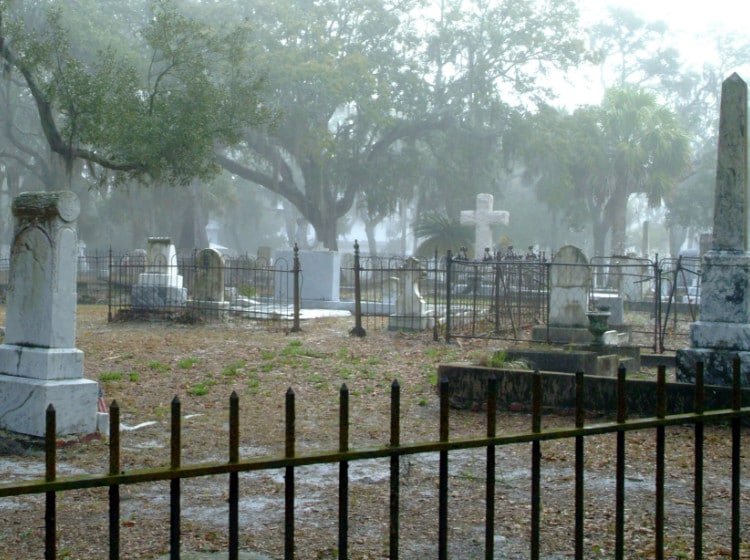7 Historical Haunts of the Forgotten Coast
By Forgotten Coast Web Team | October 27, 2020

We may be known for our beaches and seafood, but did you know that artifacts discovered in Franklin County date back to 240 AD? With such a lengthy history, it’s no wonder our area is drenched in folklore and ghost stories.
When you visit the Forgotten Coast, make sure to see these seven historical spots where ghosts and creepy legends linger.
Chestnut Street Cemetery
Apalachicola’s Chestnut Street Cemetery is a cemetery full of interesting people, known and unknown. There are at least 79 Confederate veterans, and 7 Union veterans buried there. It is a hauntingly beautiful cemetery to visit any time of year. However, it’s incredibly enlightening to see at Halloween or the first weekend in May. At these times, the Apalachicola Area Historical Society puts on a Ghost Walk through the eerily lit cemetery. AAHS members in historical garb walk you around and tell you about many famous and infamous residents who live there. You might learn about Marie Hickey, who went insane and cut her husband’s throat with a razor. Or of Rose, a mysterious servant so faithful to her employer, he chose to give her a resting place and tombstone. You might hear the tragic tale of Louisa and Frank; two teens pulled from the Apalachicola River with their arms wrapped around each other.
Whether it is a guided tour like the Ghost Walk or a walking tour on your own, a stroll through the historic Chestnut Street Cemetery in Apalachicola is a must for visitors on the Forgotten Coast.
The Coombs Inn
Built in 1905, the Coombs Inn was once the private home of Mr. and Mrs. James N. Coombs. A fire damaged the home significantly in 1911, and Mr. and Mrs. Coombs reluctantly moved into a hotel while the house was repaired. The fire’s destruction of their home was so stressful, Mrs. Coombs died of a broken heart while in the hotel. Three weeks later, Mr. Coombs’s heart failed, and he too passed on in the hotel. They are buried side by side in the Chestnut Street Cemetery across the street from their home. Coombs Inn staff have seen apparitions, heard unexplained footsteps and noises, and witnessed doors open and close by themselves. It seems Mr. and Mrs. Coombs never wanted to nor intended to leave their beloved home.
The Coombs Inn is now a bed and breakfast. It is an exclusive place to stay and a perfect springboard for a historical walk to Apalachicola’s other haunts.
The Gibson Inn
In 1923, two sisters, Annie Gibson Hayes and Mary Ellen Gibson purchased the Franklin Hotel, built in 1907, and renamed it the Gibson Inn. During WWII, the hotel was commandeered by the US Army as quarters for officers stationed at nearby Camp Gordon Johnston. Today, the recently purchased Inn is undergoing massive renovations and additions.
Common spooky encounters at the Gibson showcase Captain Wood, who died there of pneumonia. Captain Wood makes his presence known late at night in the bar and dining room with sounds of a piano playing and unexplained footsteps. Another friendly apparition reported at the Gibson is Mary Ellen “Sunshine Gibson.” She is said to gain attention by making phone calls to the guest rooms.
Referred to as the “Grande Dame of Old Florida,” the Gibson Inn offers an elegant place to stay while in Apalachicola. At the very least, we recommend taking a moment to step back in time. Order a drink from the beautifully preserved bar, sit on the breezy wrap around porch, and imagine all of the folks who sat in the same spot over the past 100+ years.
The Ghost Hearse of Bloody Bluff Cemetery
Tales told down generations are almost all that’s left of Bloody Bluff Cemetery in Franklin County south of Sumatra off of Hwy 65. The most repeated legend is the Ghost Hearse of Bloody Bluff Cemetery. Locals say a hearse was transporting a body to Blood Bluff Cemetery back in the 1960s. The hearse ran off the road and wrecked, killing the driver instantly. They say if you park your car on the railroad tracks around 3:30 am and wait, a long black rounded hearse will pull up behind you. The hearse will follow you closely and errantly down Bloody Bluff Road, flashing his bright lights the entire way in an effort to make you run off the road. And, then, the ghost hearse vanishes at the cemetery.
You may not be willing to hang around the railroad tracks in the wee hours of the morning waiting for the ghost hearse. However, it would be worth the time to take a drive to see this historic cemetery.
The Old Carrabelle Hotel
The Old Carrabelle Hotel is a historic, bright Key West style hotel in the center of Carrabelle, FL. The actual date the hotel was built is unknown. However, the current owners think it was built in the year 1900. The hotel is rumored to be haunted by several friendly ghosts. Some of the paranormal activity includes ghostly laughter, doors opening and closing on their own, cold spots, and disembodied footsteps. Sometimes on stormy nights, if guests sleep with the windows open, they hear urgent knocking on the front door like someone desperately seeking to come in from the storm.
The Old Carrabelle Hotel is a remarkable place to visit. It offers historical charm and easy-going Key West style accommodations.
Tate’s Hell
Tate’s Hell got its name from a creepy story. Armed with a shotgun, in 1875, Cebe Tate and his hunting dogs ventured into the cypress swamp in search of a panther that was killing livestock. Legend has it that his family had sworn not to venture into the cypress swamp, based on a pact Tate’s father made with a local medicine man for good fortune. Tate’s dogs tracked the panther and took off into the woods, leaving Tate all alone. Having lost his gun in the commotion, Tate wandered off alone and unarmed. He stumbled aimlessly for seven days and nights. Reappearing seven days later, snake bit and with his hair turned completely white, Tate muttered these last words before dying, “My name is Cebe Tate, and I just came from hell.”
Tate’s Hell is a Florida Forest Service recreation area, and it’s worth a trip to see the forest of dwarf cypress trees, Tate’s Hell Swamp, and the multitude of wildlife who call that area home. As you traverse well-marked trails and boardwalks, think of Tate wandering through this dangerously primitive area, unarmed and alone.
The Orman House
The Orman House was built in 1838 by Thomas Orman, a cotton merchant, and businessman. Orman helped the tiny town of Apalachicola become one of the Gulf Coast’s most important cotton exporting ports. The prominent antebellum home was used for both business and social gatherings. The house was occupied for 165 years until 1994 when the last living relative sold the home. Witnesses report unexplained footsteps and other strange sounds in the house at night. Employees tell of cryptic messages written in children’s alphabet blocks and lights turning on and off. A paranormal investigation company once came and investigated this best-known haunted house of Apalachicola. We are happy to report they concluded the house was haunted by kind and whimsical spirits.
The Orman House is now a historic state park, and the fascinating tour of the home and grounds is a bucket list item for history buffs and mystery lovers alike.
Learn more about the Forgotten Coast’s history and hauntings at our many historical sites, or book a room at one of our landmark hotels or inns. Franklin County, FL, is much more than just pristine beaches and outstanding fishing. We have a wealth of cultural, historical, and natural heritage.


